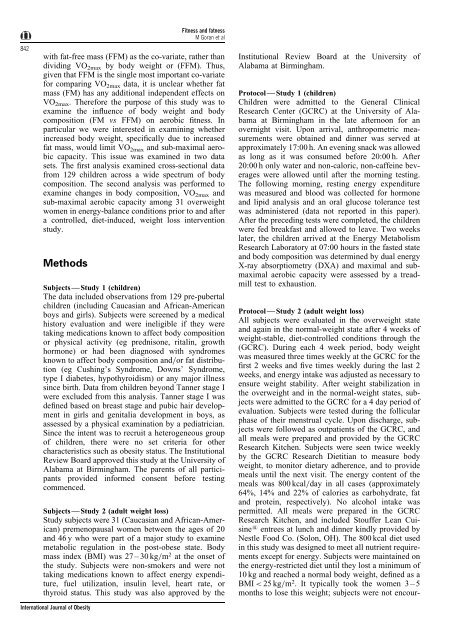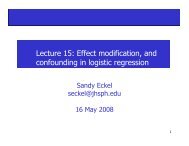Total body fat does not influence maximal aerobic capacity
Total body fat does not influence maximal aerobic capacity
Total body fat does not influence maximal aerobic capacity
You also want an ePaper? Increase the reach of your titles
YUMPU automatically turns print PDFs into web optimized ePapers that Google loves.
842<br />
with <strong>fat</strong>-free mass (FFM) as the co-variate, rather than<br />
dividing VO2max by <strong>body</strong> weight or (FFM). Thus,<br />
given that FFM is the single most important co-variate<br />
for comparing VO 2max data, it is unclear whether <strong>fat</strong><br />
mass (FM) has any additional independent effects on<br />
VO2max. Therefore the purpose of this study was to<br />
examine the in¯uence of <strong>body</strong> weight and <strong>body</strong><br />
composition (FM vs FFM) on <strong>aerobic</strong> ®tness. In<br />
particular we were interested in examining whether<br />
increased <strong>body</strong> weight, speci®cally due to increased<br />
<strong>fat</strong> mass, would limit VO 2max and sub-<strong>maximal</strong> <strong>aerobic</strong><br />
<strong>capacity</strong>. This issue was examined in two data<br />
sets. The ®rst analysis examined cross-sectional data<br />
from 129 children across a wide spectrum of <strong>body</strong><br />
composition. The second analysis was performed to<br />
examine changes in <strong>body</strong> composition, VO2max and<br />
sub-<strong>maximal</strong> <strong>aerobic</strong> <strong>capacity</strong> among 31 overweight<br />
women in energy-balance conditions prior to and after<br />
a controlled, diet-induced, weight loss intervention<br />
study.<br />
Methods<br />
Subjects Ð Study 1 (children)<br />
The data included observations from 129 pre-pubertal<br />
children (including Caucasian and African-American<br />
boys and girls). Subjects were screened by a medical<br />
history evaluation and were ineligible if they were<br />
taking medications known to affect <strong>body</strong> composition<br />
or physical activity (eg prednisone, ritalin, growth<br />
hormone) or had been diagnosed with syndromes<br />
known to affect <strong>body</strong> composition and=or <strong>fat</strong> distribution<br />
(eg Cushing's Syndrome, Downs' Syndrome,<br />
type I diabetes, hypothyroidism) or any major illness<br />
since birth. Data from children beyond Tanner stage I<br />
were excluded from this analysis. Tanner stage I was<br />
de®ned based on breast stage and pubic hair development<br />
in girls and genitalia development in boys, as<br />
assessed by a physical examination by a pediatrician.<br />
Since the intent was to recruit a heterogeneous group<br />
of children, there were no set criteria for other<br />
characteristics such as obesity status. The Institutional<br />
Review Board approved this study at the University of<br />
Alabama at Birmingham. The parents of all participants<br />
provided informed consent before testing<br />
commenced.<br />
Subjects Ð Study 2 (adult weight loss)<br />
Study subjects were 31 (Caucasian and African-American)<br />
premenopausal women between the ages of 20<br />
and 46 y who were part of a major study to examine<br />
metabolic regulation in the post-obese state. Body<br />
mass index (BMI) was 27 ± 30 kg=m 2 at the onset of<br />
the study. Subjects were non-smokers and were <strong>not</strong><br />
taking medications known to affect energy expenditure,<br />
fuel utilization, insulin level, heart rate, or<br />
thyroid status. This study was also approved by the<br />
International Journal of Obesity<br />
Fitness and <strong>fat</strong>ness<br />
M Goran et al<br />
Institutional Review Board at the University of<br />
Alabama at Birmingham.<br />
Protocol Ð Study 1 (children)<br />
Children were admitted to the General Clinical<br />
Research Center (GCRC) at the University of Alabama<br />
at Birmingham in the late afternoon for an<br />
overnight visit. Upon arrival, anthropometric measurements<br />
were obtained and dinner was served at<br />
approximately 17:00 h. An evening snack was allowed<br />
as long as it was consumed before 20:00 h. After<br />
20:00 h only water and non-caloric, non-caffeine beverages<br />
were allowed until after the morning testing.<br />
The following morning, resting energy expenditure<br />
was measured and blood was collected for hormone<br />
and lipid analysis and an oral glucose tolerance test<br />
was administered (data <strong>not</strong> reported in this paper).<br />
After the preceding tests were completed, the children<br />
were fed breakfast and allowed to leave. Two weeks<br />
later, the children arrived at the Energy Metabolism<br />
Research Laboratory at 07:00 hours in the fasted state<br />
and <strong>body</strong> composition was determined by dual energy<br />
X-ray absorptiometry (DXA) and <strong>maximal</strong> and sub<strong>maximal</strong><br />
<strong>aerobic</strong> <strong>capacity</strong> were assessed by a treadmill<br />
test to exhaustion.<br />
Protocol Ð Study 2 (adult weight loss)<br />
All subjects were evaluated in the overweight state<br />
and again in the normal-weight state after 4 weeks of<br />
weight-stable, diet-controlled conditions through the<br />
(GCRC). During each 4 week period, <strong>body</strong> weight<br />
was measured three times weekly at the GCRC for the<br />
®rst 2 weeks and ®ve times weekly during the last 2<br />
weeks, and energy intake was adjusted as necessary to<br />
ensure weight stability. After weight stabilization in<br />
the overweight and in the normal-weight states, subjects<br />
were admitted to the GCRC for a 4 day period of<br />
evaluation. Subjects were tested during the follicular<br />
phase of their menstrual cycle. Upon discharge, subjects<br />
were followed as outpatients of the GCRC, and<br />
all meals were prepared and provided by the GCRC<br />
Research Kitchen. Subjects were seen twice weekly<br />
by the GCRC Research Dietitian to measure <strong>body</strong><br />
weight, to monitor dietary adherence, and to provide<br />
meals until the next visit. The energy content of the<br />
meals was 800 kcal=day in all cases (approximately<br />
64%, 14% and 22% of calories as carbohydrate, <strong>fat</strong><br />
and protein, respectively). No alcohol intake was<br />
permitted. All meals were prepared in the GCRC<br />
Research Kitchen, and included Stouffer Lean Cuisine<br />
1 entrees at lunch and dinner kindly provided by<br />
Nestle Food Co. (Solon, OH). The 800 kcal diet used<br />
in this study was designed to meet all nutrient requirements<br />
except for energy. Subjects were maintained on<br />
the energy-restricted diet until they lost a minimum of<br />
10 kg and reached a normal <strong>body</strong> weight, de®ned as a<br />
BMI < 25 kg=m 2 . It typically took the women 3 ± 5<br />
months to lose this weight; subjects were <strong>not</strong> encour-




